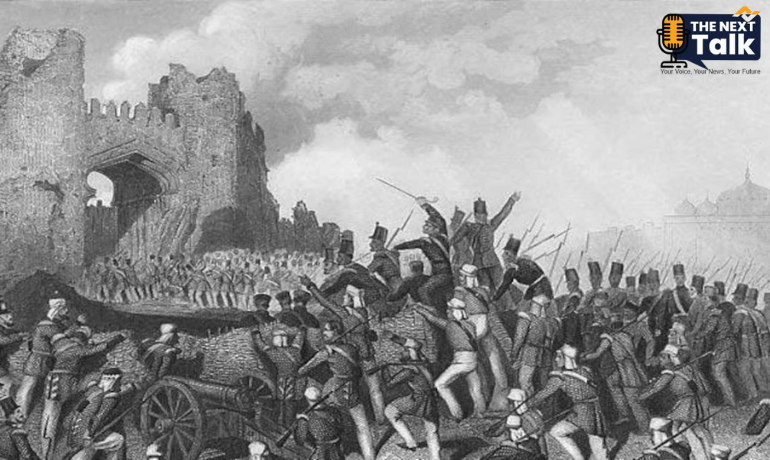The First War of Indian Independence in 1857, often called the Sepoy Mutiny or the Indian Rebellion of 1857, marked a crucial turning point in India’s long fight for freedom. It was not merely a rebellion of soldiers but a mass uprising involving different sections of Indian society who were discontented with British colonial rule. While the immediate cause was the introduction of new rifle cartridges allegedly greased with animal fat, deeper economic, political, and social causes were at play. This blog delves into the origins, key events, and long-term impact of this monumental struggle in Indian history.
Causes of the First War of Indian Independence
1. Political Causes
One of the primary causes of the 1857 uprising was the aggressive expansion policies of the British East India Company. Through the Doctrine of Lapse, Indian rulers who did not have a male heir saw their kingdoms annexed by the British. The annexation of princely states like Jhansi, Satara, and Awadh caused widespread resentment among Indian rulers. The unfair treatment of Indian royalty created a growing dissatisfaction among local leaders, which contributed to the rebellion.
2. Economic Causes
The exploitative economic policies of the British had devastated India’s economy. Heavy taxation, the ruin of traditional handicrafts, and the imposition of the zamindari system displaced many farmers and artisans. The once-thriving Indian textile industry, for instance, was systematically destroyed as the British flooded Indian markets with machine-made goods. This economic strain led to widespread poverty and fueled anger toward colonial rule.
3. Social and Religious Causes
The British administration showed little respect for Indian religious and social customs. Reforms such as the abolition of Sati and the introduction of Western education were seen as attempts to undermine traditional Indian values. The perception that the British were intent on converting Hindus and Muslims to Christianity created fear and distrust among the population. The introduction of the Enfield rifle, with its cartridges rumored to be greased with cow and pig fat, further inflamed religious sentiments, especially among Hindu and Muslim soldiers.
4. Military Causes
Indian soldiers, or sepoys, formed a significant part of the British army in India, yet they were treated as second-class citizens. They faced discrimination in pay, promotions, and general treatment compared to their British counterparts. The final spark was the introduction of the Enfield rifle in 1857, as loading the rifle required soldiers to bite into cartridges rumored to contain animal fat. This was considered heretical for both Hindus and Muslims, and it united soldiers from different backgrounds against the British.
Major Events of the 1857 Uprising
1. The Revolt in Meerut
The revolt began on May 10, 1857, in Meerut when sepoys refused to use the new rifle cartridges. As a result, 85 sepoys were court-martialed and imprisoned. The next day, their fellow soldiers mutinied, attacked British officers, and freed the imprisoned sepoys. The revolt quickly spread to nearby areas, beginning a nationwide rebellion.
2. The Siege of Delhi
After the revolt in Meerut, the rebels marched toward Delhi and declared Bahadur Shah Zafar, the last Mughal emperor, as the symbolic leader of the uprising. The capture of Delhi gave the rebellion both a moral and strategic advantage. However, British forces recaptured the city after a fierce battle in September 1857.
3. Rani Lakshmibai and the Battle of Jhansi
One of the most iconic figures of the revolt was Rani Lakshmibai of Jhansi, who fiercely resisted the British forces. Her kingdom had been annexed under the Doctrine of Lapse. Leading her army with unparalleled bravery, she fought valiantly in the Battle of Jhansi but was ultimately killed in combat. Her role in the 1857 rebellion made her a symbol of resistance and courage.
4. The Siege of Lucknow
Lucknow, the capital of Awadh, saw one of the longest sieges of the 1857 uprising. The city was a stronghold of the rebels under the leadership of Begum Hazrat Mahal. The British Residency in Lucknow was besieged for months before British forces were able to recapture it. The siege of Lucknow was a pivotal moment in the rebellion, demonstrating the strength of the Indian resistance.
Key Figures of the First War of Independence
1. Bahadur Shah Zafar
The last Mughal emperor, Bahadur Shah Zafar, played a symbolic role in the 1857 uprising. Though he was not a military leader, his name carried great weight. The rebels declared him the leader of the revolt, hoping to unite Indians under his banner. After the rebellion, he was captured by the British and exiled to Burma.
2. Mangal Pandey
The revolt began in part due to the actions of sepoy Mangal Pandey, who refused to use the new cartridges and attacked his British officers. His actions in Barrackpore on March 29, 1857, are often seen as the first spark of the rebellion. He was executed, but his defiance inspired many other soldiers to join the fight.
3. Rani Lakshmibai
As the queen of Jhansi, Rani Lakshmibai became one of the leading figures of the 1857 uprising. Her refusal to surrender to the British and her leadership in battle made her a hero of the rebellion. She fought with great courage and is remembered as one of India’s first freedom fighters.
4. Nana Sahib
Nana Sahib, the adopted son of the last Peshwa of the Marathas, was one of the prominent leaders of the rebellion. After his pension was denied by the British, he led a major uprising in Kanpur. Though the British eventually regained control, Nana Sahib’s leadership made Kanpur a key battleground.
Aftermath and Impact
The revolt of 1857 was eventually suppressed by the British by mid-1858, but its impact was profound. The British East India Company was dissolved, and the administration of India was taken over directly by the British Crown, marking the beginning of the British Raj. The rebellion exposed the vulnerabilities of British rule and instilled a sense of national consciousness among Indians. Although the 1857 uprising did not succeed in overthrowing British rule, it laid the foundation for future independence movements.
Conclusion
The First War of Indian Independence in 1857 was a watershed moment in India’s history. It was a collective outcry against oppression, uniting different sections of Indian society in their fight against colonial rule. While it was eventually quelled, the courage and determination displayed by the leaders and participants of the revolt continue to inspire India’s ongoing struggle for justice and freedom.






